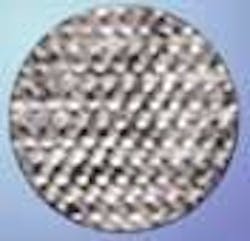Image processing reveals lithium atoms
Collaborating researchers at three institutions have used sophisticated image-processing techniques to achieve an effective 0.8 Å of resolution through a 1.0-Å transmission electron microscope, and to actually observe lithium atoms for the first time.
Yang Shao-Horn at the Massachusetts Institute of Technology (MIT; Cambridge, MA) and Michael O'Keefe at Lawrence Berkeley National Laboratory (LBNL; Berkeley, CA) used the One Angstrom Microscope (OÅM) at the LBNL National Center for Electron Microscopy (NCEM) and the help of colleagues at the University of
Bordeaux I (Bordeaux, France) to simultaneously resolve columns of lithium, cobalt, and oxygen atoms in the compound lithium cobalt oxide (LiCoO2), which is commonly used in the positive electrodes of lithium rechargeable batteries that are widely used in laptop computers, digital cameras, and many other devices.
The structure of LiCoO2 is known theoretically and has been confirmed with techniques like x-ray diffraction and neutron powder diffraction. But lithium ions have never been seen with these techniques, nor have they been seen in previous attempts to image LiCoO2 with electron microscopy. Cobalt, with atomic number 27 and atomic mass approaching 60, is relatively easy to image, but oxygen, with atomic number 8 and atomic mass about 16, scatters electrons weakly. Lithium is smaller still, with an atomic number of only 3 and an atomic mass of 7.
Two-step process
The 1.6-Å native resolution (smallest distinguishable distance between adjacent objects) of the OÅM is good enough to resolve cobalt atoms directly. But imaging smaller atoms requires approaching the microscope's 0.78-Å information limit (maximum amount of information about the sample that can be extracted from the scattered electron wave, even those portions of it that may be out of phase). The researchers achieved this using a focal-series-reconstruction image-processing method in which successive images, each made at a slightly different focus, were combined. Because the separate images in the series were focused differently, however, in-phase images of atoms in one image were out of phase in another. So a two-step process was required.
The first image-processing step created a high-resolution simulation of the expected image by starting with a model of the material's crystal structure and then adding specific parameters such as atomic specifications, the thickness and orientation of the sample, the energy of the microscope's electron beam, lens aberrations, beam misalignments, and other characteristics of both the sample and the instrument. The simulation showed that in a sample of the right thickness, lithium ions should become visible at 1 Å. At 0.8 Å, all three kinds of atoms should be clearly visible.
The second image-processing step involved taking the experimental images and working backward to produce a representation of the electron wave leaving the exit surface of the specimen. After confirming the focal value for each image in the series, Shao-Horn and her colleagues used the reconstruction program to produce an image from a small area of a thin edge of a LiCoO2 crystal, which matched the one predicted by the simulation program.1
"Because material from which some lithium ions are removed is somewhat unstable under the electron beam, experimental imaging of the lithium ions and vacancies proved difficult in this study," says Shao-Horn. "Nevertheless, the atomic resolution of lithium atoms is a novel and significant achievement, with implications for better understanding not only of lithium ion battery materials but of many other electroceramic materials as well."
The results also indicate that the range of mid-voltage microscopes such as the OÅM, can be extended all the way from heavy atoms down through oxygen, nitrogen, and carbon to the lightest metal, with only the two lightest elements, helium and hydrogen, remaining out of reach, O'Keefe said.
REFERENCE
- Y. Shao-Horn et al., Nature Materials 2, 464 (2003).

